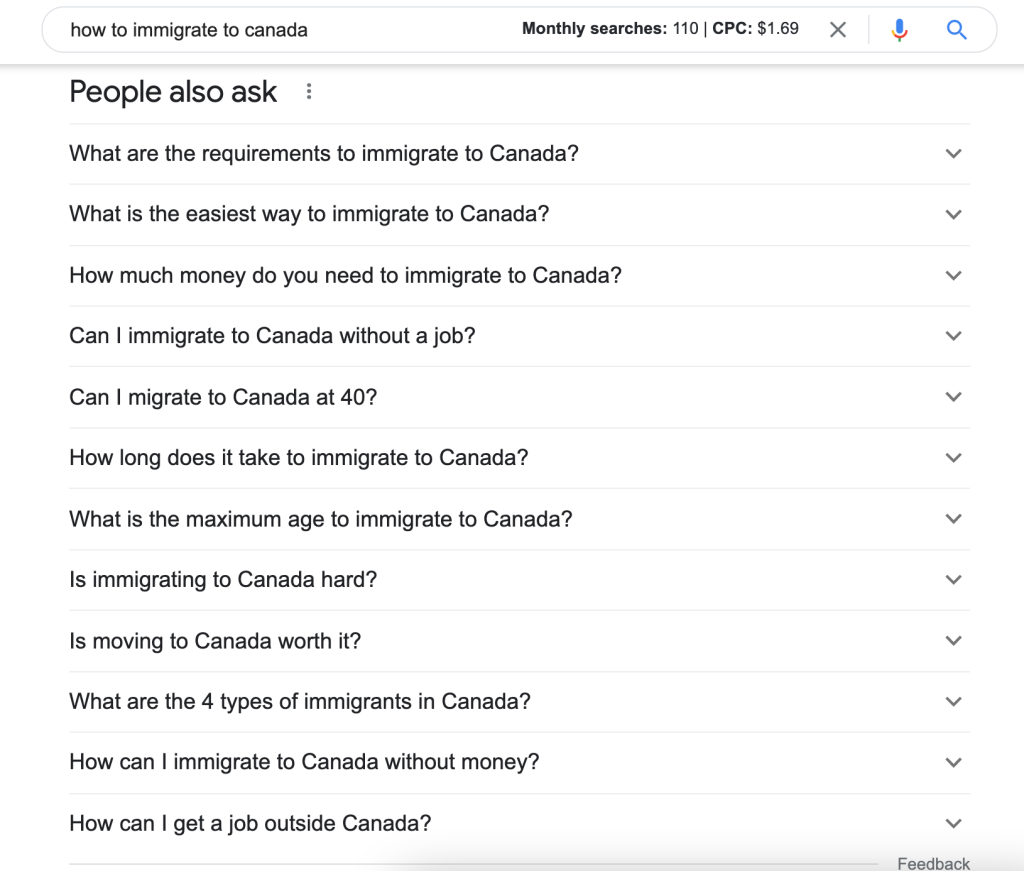Content marketing is an incredible tool for immigration law firms and migration consultants – and blogging is an easy way to boost your content marketing efforts. But generating fresh ideas for blog posts can be time-consuming. In this post, we’ll outline 10 blog post topic ideas for immigration law firms and service professionals.
- Why should immigration law firms have a blog?
- 10 Blog Post Ideas for Immigration Law Firms
- Answer frequently asked questions.
- Provide resources and information immigrants need.
- Blog about how to avoid common pitfalls when immigrating.
- Updates about new developments in immigration.
- An explanation of immigration-related court cases.
- Immigration statistics.
- Details about the country you help people immigrate to.
- Example timelines for common immigration pathways.
- Explanatory guides outlining documentation requirements.
- Explanatory guides outlining eligibility requirements
- Answer frequently asked questions.
- How long should your immigration law firm’s blog posts be?
Why should immigration law firms have a blog?
Blogs are an incredible tool for (almost) any business. They help you create connections, establish yourself as a trusted source, and increase your value-add, while also improving your SEO outcomes. Consider these compelling business blogging statistics:
- Companies with a blog receive 67% more leads.
- Websites with blogs receive more traffic. (Each of our blogging clients receives 1000s of website hits each year from their blog posts).
- Marketers that prioritise blogging see a 13 x greater ROI.
- Generating blog posts is cheaper and more effective than traditional marketing.
What information should immigration law firms share on their blog?
Blogs can help immigration lawyers and consultants share timely information that’s subject to change. Conversely, your website’s pages should contain information and details that are relatively time resistant – like your descriptions of specific types of visas.
Uncertain about what categories of content fall into that “timely and subject to change category”? Read on.
10 Blog Post Ideas for Immigration Law Firms
Coming up with content ideas is half the battle. To make it easier for you to brainstorm ideas, we’ve created this list of 10 blog post ideas for immigration law firms:
Answer frequently asked questions.
You regularly speak with your clients, so you likely have a fairly good grasp of what information they need based on what questions you commonly hear. Answering these common questions on your blog performs several valuable functions, they allow you to:
- Save time (cumulatively) by sending clients a link with relevant information instead of rewriting the same information in various emails when the inquiries trickle in. This also frees you up to focus on the more interesting aspects of your clients’ files, instead of the repetitive queries.
- Demonstrate competence and understanding by preempting their pain points and solving them before the client even needs to ask.
- Increase the perceived value of your services. By creating and making ‘free’ resources available to your potential clients, they may feel like they have derived more value from your services.
- Improve SEO and increase your chances for backlinks, which can improve your search engine rankings.
How to Generate Your List of FAQs for Blog Posts:
Here are a few ways you can generate a list of ideas for blog posts:
- Create a Google Spreadsheet or other shared document for your firm and let your team know to add their ideas to the sheet.
- Brainstorm during a staff meeting.
- See what your competitors are writing about. No harm in using their content for ideas, but don’t copy the posts too closely. Copyright aside, Google isn’t a fan of duplicate content.
- Play alphabet soup on Google. This is a (really easy) way to see what other users are commonly searching for. You just type a broad query in and then go through the alphabet one letter at a time, like so:


- Check out the ‘People Also Asked’ function on Google.

Generally, when you search on Google it will show you similar queries that ‘People Also Ask’. This is a great feature you can use to select novel blog post ideas, as well as to bulk out a blog post that isn’t quite long enough yet.
You can also scroll to the bottom of the first page on Google for further ideas:

Provide resources and information immigrants need.
I have recently discovered a ‘content gap’ in the resources provided to immigrants moving to British Columbia, Canada (as I am one myself). Immigrants are left to themselves to learn whether they are eligible for healthcare and how to get access to it, as well as needing to find information about keeping a driver’s license while on maintained status – the list goes on.
The reality is that everything is foreign when you move to a new country. By providing resources with helpful information for new immigrants, your law firm provides additional value for its clients. Here are some resources we recommend compiling and making available to your clients:
- Job boards commonly used in your location.
- Local banks, including details about services offered to new immigrants.
- Driver’s licencing information.
- Access to healthcare information.
- A list of large supermarkets and the location of major malls.
- How to access public transport and/or reputable taxi providers.
It’s best to compile this information and deliver it in a neat and branded package (whether that’s online, in person, or both).
Blog about how to avoid common pitfalls when immigrating.
Immigration is a daunting process. By providing details of common pitfalls and how to avoid them, you show potential clients that you understand their experience and can empathise with their pain points. It also demonstrates competence and helps to position you as a trusted resource for information about immigration.
Here are some ideas to cover:
- How to avoid scam immigration services providers. (Insert a link showing your registration/status as a legitimate provider, if you can).
- Common mistakes made when applying for (insert visa type here) – and how to avoid them.
- How to avoid the common mistakes made in your immigration language test.
Updates about new developments in immigration.
Is there a new pathway for immigrants? Has the timeline for applications in a specific program gotten longer? Write a blog post outlining the change!
Any time that government agencies adjust their immigration policies, introduce (or eliminate) new pathways for immigration, or otherwise make changes that may impact your clients, it can be beneficial to cover the development on your blog. It shows your website visitors (and potential clients) that you’re on the pulse when it comes to immigration matters.
An explanation of immigration-related court cases.
Most of your audience won’t know how to access immigration-related court decisions, nor will they necessarily understand their implications. Explaining these decisions to your audience can help them to better understand the law and potentially some procedural aspects of their case. However, it’s important that you bear your audience in mind when sharing immigration case-related content.
Bearing the audience in mind, this category of blog post ideas may be less relevant for migration consultants. But for immigration lawyers, explaining recent cases can help to position you as an expert. It is critically important that you explain the decisions in language and use a format that will make sense to most of your readers. If they leave the blog post confused, it may not inspire confidence in your ability to relate to them, which can be offputting for some potential clients.
Bonus tip: Cover high profile immigration matters that are in the news!
You might also consider covering ‘what went wrong’ in high profile immigration cases. They don’t arise often, but you can score bonus points by covering topics your audience (and many others) are likely to be interested in. Australian immigration services providers had this opportunity recently throughout the Novak Djokovic saga.
Immigration statistics.
Sharing immigration-related statistics with your audience can be powerful and empowering. You can share the details about how many foreign nationals are choosing your country to study, why they are choosing it, and provide some information about student visas. Similarly, you might choose to provide details about the labour market and/or job vacancies alongside government policies to address labour shortages, and how immigrants can fill those gaps. Or, in the pursuit of attracting potential clients who want to enter the country as a tourist, share the most visited cities in your country.
Since immigration statistics are of interest to potential immigrants, they are likely searching for those answers. This means your immigration law firm or migration consultancy may have a chance to rank highly on a search engine for the search terms.
Details about the country you help people immigrate to.
You should feel free to highlight the best features of the country for which you provide immigration services. Again, it’s important to consider your audience here when determining which information to share. Remember at all times that you’re an immigration services provider, not a travel agent.
Here are some ideas for content to share about the country (or countries) you help people immigrate to or visit:
- What are the best universities in (the country)?
- Which cities are most attractive to tourists in (the country) – assuming you offer visitor visa services.
- Success stories where immigrants have moved to (the country) and built a thriving business.
Example timelines for common immigration pathways.
Your potential clients are almost certainly going to be curious about how long the immigration process takes. Creating timelines for them is a great way to preempt this query, while also helping them to better understand the process – and all the work involved. It also demonstrates that you know the processes well, which can be reassuring for clients looking for a quality immigration services provider.
The Australian Government’s website contains detailed ‘step-by-step’ guides to the immigration process. You could easily use their ‘step-by-step’ pages as a guide for what to include in the blog posts you create for these timelines. Once you’ve broken the process down to its ‘steps’ add details about how long each step typically takes.
There are blog post ‘timeline’ templates readily available on WordPress and plenty of plugins you can use to create stunning visualisations for the timelines you plan to post about. If you don’t have the expertise in house to develop ‘timeline’ blog posts, it may be worthwhile outsourcing the design for the first timeline post to a professional. Once you have the visualisation up and running, you can easily duplicate the blog post and update the content for future posts!
Explanatory guides outlining documentation requirements.
Regardless of which visa or permit your potential clients are planning to apply for, there are likely going to be documentation requirements. Your potential clients are likely to have questions about these documentation requirements – and your immigration law firm blog is a good place to preempt and answer those questions.
Here are some example headlines you might consider for this category of blogs:
- How to obtain a police certificate to immigrate to (country name).
- A comprehensive guide to the documents do you need to apply for (insert visa/permit category).
- Which documents should you submit to provide evidence of your relationship for a partner visa to (country)?
Explanatory guides outlining eligibility requirements
Similar to the point above, you can create blog posts that outline specific details about eligibility requirements. Again, your potential clients likely have questions about their eligibility and answering those questions on your blog can help to drive traffic and establish your law firm or migration consultancy as a trusted resource.
Here are some example blog titles you might consider for this category of blog posts:
- What are the requirements for getting a (insert visa type) for (country)?
- How much money do you need to get PR and move to (country)?
- Here’s how you can sponsor your partner to move to (country).
- A guide to the eligibility requirements for citizenship to (country).
How long should your immigration law firm’s blog posts be?
Here’s the content from a post we shared on our Instagram page with a few facts and figures about blog post length:


💡 The solution: Different length blog posts for different marketing purposes!
If you’re sending out your blog posts in your email marketing campaigns or you’re hoping to slowly increase your rankings in a cost-effective manner, shorter posts might be for you.
Are you hoping to quickly attract leads for specific keywords or you’re in a particularly competitive market? Long posts might be the way to go.
If you’re uncertain what to do, experiment with posts of varying lengths for a year and see what the data tells you. And remember: What works for one firm might not work for yours!
In essence, longer blog posts tend to perform better when it comes to being found via search engines. They’re also more likely to be shared via social media. However, your audience is still likely to be interested in your shorter-form content.
The reality is that a published blog post of any length is going to perform better than a post you never write or publish at all. It’s also important to remember that you can (and should) update and add to the blog posts you’ve previously published. So, again, if you’ve only got time to draft and publish a short post – it’s better to do that than nothing at all.
If you need assistance with your immigration law firm’s blog posts, reach out. We would be thrilled to help!







Leave A Comment
You must be logged in to post a comment.